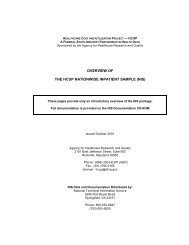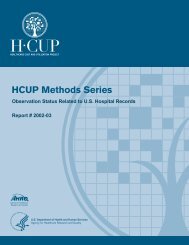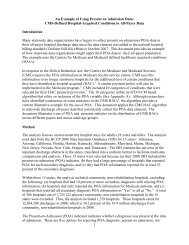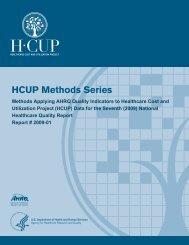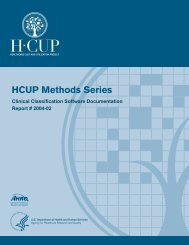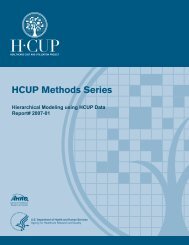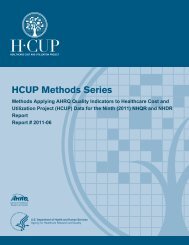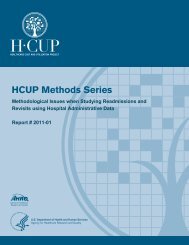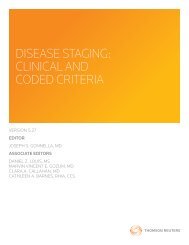Origin of Adverse Drug Events in U.S. Hospitals, 2011 - HCUP
Origin of Adverse Drug Events in U.S. Hospitals, 2011 - HCUP
Origin of Adverse Drug Events in U.S. Hospitals, 2011 - HCUP
You also want an ePaper? Increase the reach of your titles
YUMPU automatically turns print PDFs into web optimized ePapers that Google loves.
F<strong>in</strong>d<strong>in</strong>gs<br />
Frequency <strong>of</strong> adverse drug events, <strong>2011</strong><br />
Across a total <strong>of</strong> 20,172,966 discharges <strong>in</strong> the 32 States <strong>in</strong>cluded <strong>in</strong> our analysis, there were 782,757<br />
ADEs that were present on admission and 259,662 ADEs that orig<strong>in</strong>ated dur<strong>in</strong>g the hospital stay. Table 1<br />
presents the rate and percentage <strong>of</strong> ADEs for a range <strong>of</strong> causes. Overall, ADEs observed dur<strong>in</strong>g<br />
hospitalization were more likely to be present on admission (388 per 10,000 discharges) than to orig<strong>in</strong>ate<br />
dur<strong>in</strong>g the hospital stay (129 per 10,000 discharges). Among ADEs present on admission, the most<br />
common general causes were antibiotics and anti-<strong>in</strong>fectives (23.4 percent <strong>of</strong> all ADEs), systemic agents<br />
(13.6 percent), nonspecific ADE causes (12.9 percent), and hormones (11.9 percent). Among ADEs that<br />
orig<strong>in</strong>ated dur<strong>in</strong>g the stay, the most prevalent general causes were antibiotics and anti-<strong>in</strong>fectives (28.0<br />
percent <strong>of</strong> all ADEs), nonspecific ADE causes (16.6 percent), hormones (16.1 percent), and analgesics<br />
(12.6 percent).<br />
Table 1. <strong>Adverse</strong> drug events (ADEs) <strong>in</strong> hospital <strong>in</strong>patient sett<strong>in</strong>gs, 32 states, <strong>2011</strong><br />
<strong>Adverse</strong> drug event cause a<br />
ADEs based on diagnoses<br />
present on admission<br />
Number <strong>of</strong><br />
ADEs<br />
per 10,000<br />
discharges<br />
Percent <strong>of</strong><br />
ADEs b<br />
ADEs based on diagnoses<br />
that orig<strong>in</strong>ated dur<strong>in</strong>g the<br />
hospital stay<br />
Number <strong>of</strong><br />
ADEs<br />
per 10,000<br />
discharges<br />
Percent <strong>of</strong><br />
ADEs b<br />
Any ADE cause 388.0 100.0 128.7 100.0<br />
Antibiotics and anti-<strong>in</strong>fectives 90.9 23.4 36.1 28.0<br />
Antibiotics 12.5 3.2 12.9 10.0<br />
Clostridium difficile <strong>in</strong>fection 14 73.1 18.8 21.9 17.1<br />
Other anti-<strong>in</strong>fectives 6.3 1.6 1.7 1.3<br />
Hormones 46.3 11.9 20.7 16.1<br />
Steroids 37.3 9.6 19.7 15.3<br />
Insul<strong>in</strong> and hypoglycemics 7.1 1.8 0.8 0.6<br />
Other hormones 3.0 0.8 0.3 0.2<br />
Systemic agents 52.8 13.6 8.5 6.6<br />
Ant<strong>in</strong>eoplastic drugs 49.2 12.7 7.8 6.0<br />
Antiallergy and antiemetic drugs 3.1 0.8 0.7 0.5<br />
Other systemic agents 0.8 0.2 0.1 0.1<br />
Agents affect<strong>in</strong>g blood constituents 43.9 11.3 8.5 6.6<br />
Anticoagulants 40.6 10.5 6.7 5.2<br />
Other agents that affect blood constituents 3.9 1.0 1.9 1.5<br />
Analgesics 45.5 11.7 16.2 12.6<br />
Opiates/Narcotics 18.8 4.9 11.2 8.7<br />
NSAIDS 28.3 7.3 5.1 4.0<br />
14 Clostridium difficile <strong>in</strong>fection (CDI) <strong>of</strong>ten occurs as a complication <strong>of</strong> antibiotic therapy; ampicill<strong>in</strong>, cl<strong>in</strong>damyc<strong>in</strong>, third-generation<br />
cephalospor<strong>in</strong>s (such as cefotaxime and ceftazidime), and fluoroqu<strong>in</strong>olones are commonly identified as high-risk drugs. From:<br />
Blondeau JM. What have we learned about antimicrobial use and the risks for Clostridium difficile-associated diarrhoea? Journal <strong>of</strong><br />
Antimicrobial Chemotherapy 2009;63(2):230–7.<br />
3



